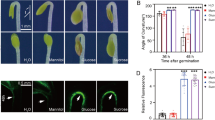Abstract.
Shoots of the lazy-2 mutant of tomato (Lycopersicon esculentum Mill., cv. Ailsa Craig) exhibit negative gravitropism in the dark, but respond positively gravitropically in (red) light. In order to test whether high-gradient magnetic fields (HGMFs) exert only ponderomotive effects on amyloplasts or affect other physiological processes, we induced magnetophoretic curvature in wild-type (WT) and lazy-2 mutant seedlings. Straight hypocotyls of 4-d-old plants were selected and the tips of their hooks were placed in an HGMF near the edge of a magnetized ferromagnetic wedge [grad (H2/2) ≈ 109–1010 Oe2/cm] and mounted on a 1-rpm clinostat. After 4 h in the dark, 85% of WT hypocotyls and 67% of mutant hypocotyls curved toward the wedge. When the seedlings were exposed to red light for 1 h prior to and during the application of the HGMF, 78% of the WT seedlings curved toward the magnetic gradient, but the majority of the lazy-2 seedlings (75%) curved away from the stronger field area. Intracellular amyloplast displacement in the HGMF was similar for both varieties and resembled the displacement after horizontal reorientation. The WT showed a distinct graviresponse pattern depending on the orientation of the hook, even after excision of the apex. Application of HGMFs to decapitated hypocotyls resulted in curvature consistent with that obtained after horizontal reorientation. After light exposure, decapitated lazy-2 seedlings did not respond positively gravitropically. The data imply that the lazy-2 mutants perceive the displacement of amyloplasts in a similar manner to the WT and that the HGMF does not affect the graviresponse mechanism. The study demonstrates that ponderomotive forces due to HGMFs are useful for the analysis of the gravity-sensing mechanism in plants.
Similar content being viewed by others
Author information
Authors and Affiliations
Additional information
Received: 31 August 1998 / Accepted: 6 October 1998
Rights and permissions
About this article
Cite this article
Hasenstein, K., Kuznetsov, O. The response of lazy-2 tomato seedlings to curvature-inducing magnetic gradients is modulated by light. Planta 208, 59–65 (1999). https://doi.org/10.1007/s004250050534
Issue Date:
DOI: https://doi.org/10.1007/s004250050534




